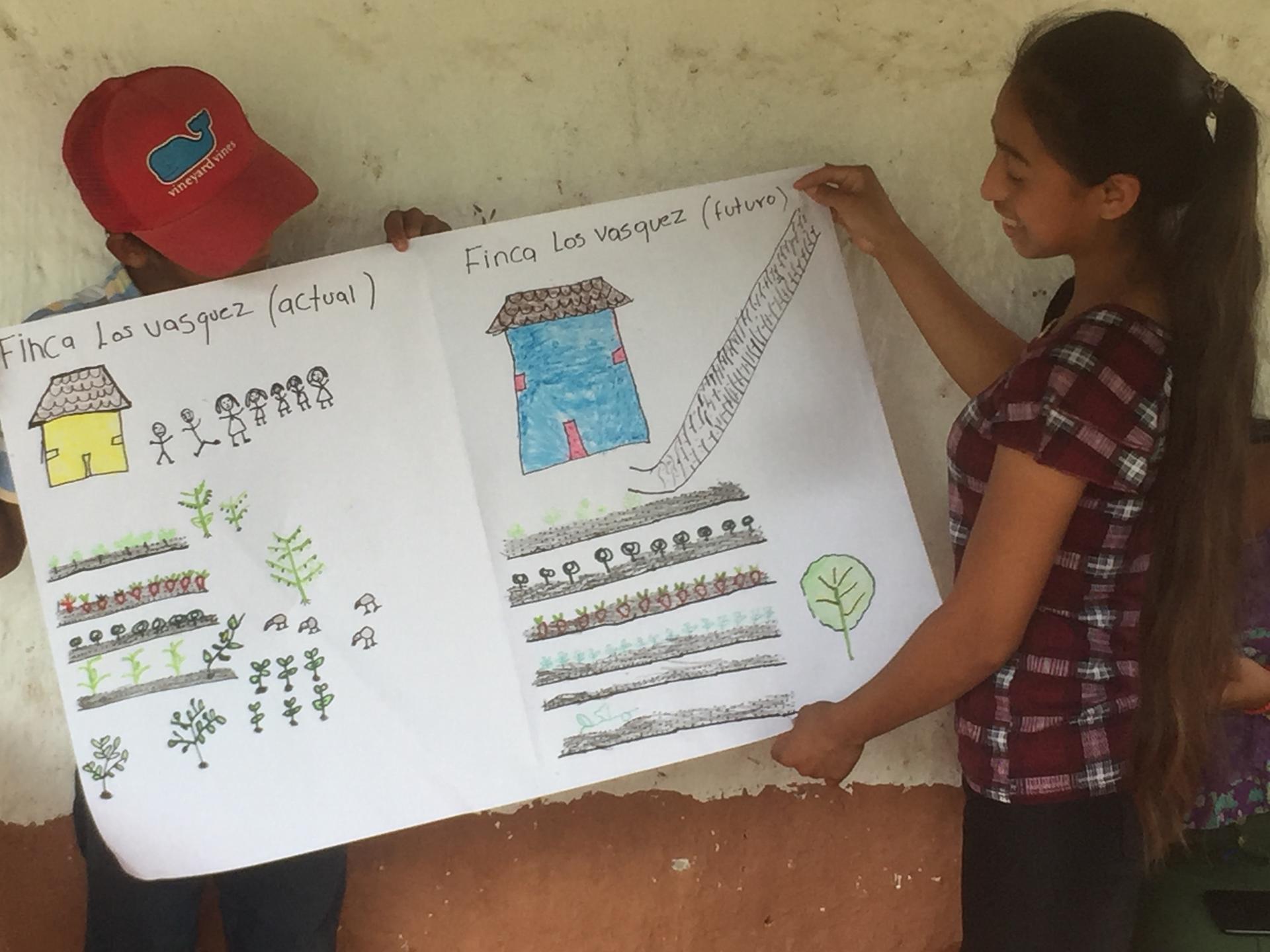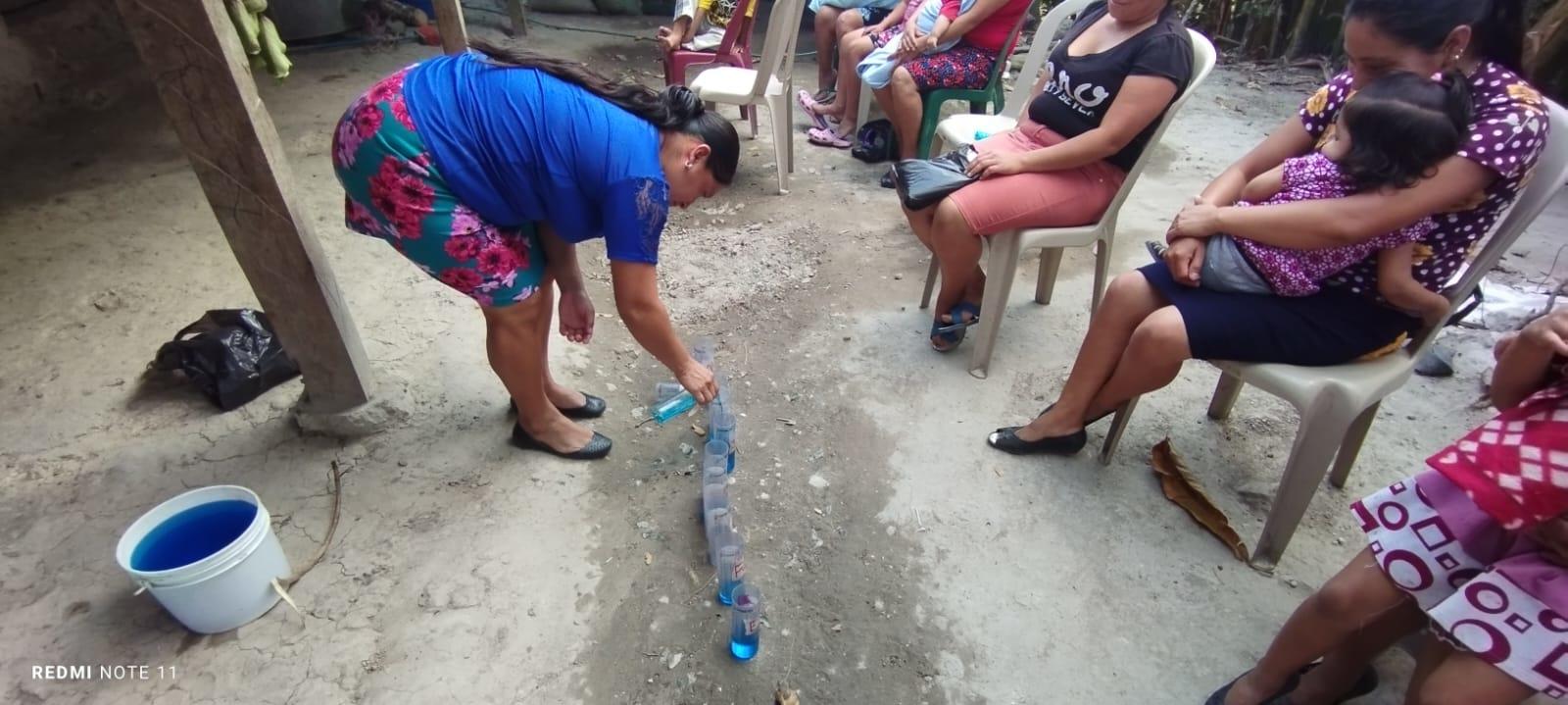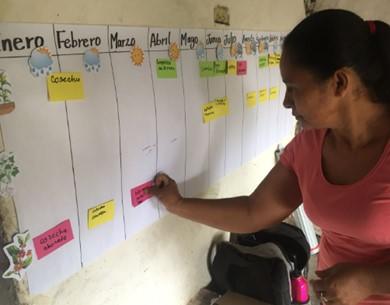Blog Informed decisions in a changing climate: Experiences of implementing the PICSA methodology in Climate-smart villages (Guatemala and Honduras)

Access, knowledge, and management of agroclimatic information for farmers is fundamental, as it allows them to make informed decisions and adapt to climate variations. Farmers are highly dependent on climate for food production; however, climate variability can have a significant impact on crop production, so access to and understanding of agroclimatic information in a timely manner can make a difference to farmers' yields and livelihoods.

In search of reducing the climate vulnerability of families, improving agroecosystems and strengthening the Sustainable Agriculture Adapted to Climate (ASAC) approach, the Bioversity International Alliance and CIAT, together with implementing partners ASORECH in Guatemala and CASM in Honduras, are working collaboratively on the project "Putting Ecosystems at the Center of Adaptation through the Sustainable Territories Adapted to Climate Approach (TESAC)"Approach," funded by the Global EbA Fund implemented by The Internacional Union for Conservation of Nature (UICN), through the implementation of Ecosystem-based Adaptation (EbA) practices.
This project, implemented in the municipalities of Olopa (Guatemala) and Santa Rita (Honduras), is benefiting approximately 214 producer families in 10 communities in the area, with the objective of reducing the climate vulnerability of farmers through the implementation of the Participatory Integrated Climate Services for Agriculture (PICSA) methodology. This approach seeks to strengthen farmers' decision-making by facilitating access to accurate and specific agroclimatic information for use in resilient adaptation practices in the face of climate variability.
Thus, the implementation of the PICSA methodology has addressed fundamental issues for the interpretation of agroclimatic data, strengthening the farmer's arguments for making strategic decisions, with seasonal forecasts and agroclimatic bulletins.
Additionally, during the approach with the communities, the implementing teams (ASORECH and CASM) found in PICSA a valuable tool to promote informed and adapted decision-making by farmers in their territories, identifying challenges and opportunities for improvement in the use and management of climate information, a topic that, although vital, due to its various variables, requires a detailed explanation to be understood and executed correctly.
How has the use of climate information addressed with the PICSA methodology contributed to the empowerment of farmers?
One of the most significant achievements has been the integration of this new knowledge by farmers to dimension the different rainfall harvesting measures, homologizing the technical language with experimental evidence, which strengthens their notions thanks to the incorporation of the PICSA methodology, while empowerment continues in agroclimatic and meteorological information, livestock species management and productive activities.
On the other hand, thanks to the level of precision of the agroclimatic perspectives provided in the socializations, greater confidence has been generated for farmers to make use of the information provided, in addition to generating greater use of the recommendations given through Local Technical Agro-Climatic Committees (MTAs, by its acronym in Spanish).
This is how Carlos and Veronica have strengthened their decision-making skills and improved their productive activities, gaining greater control over their crops, avoiding crop losses, and recommending the use of the methodology to more farmers to generate better and higher profits.
What materials or tools do farmers prefer for understanding climate information?
The PICSA methodology manual contains a series of graphic tools, matrices and detailed procedures that facilitate the empowerment of the use of climate information. However, in the implementations carried out in 2022 and 2023, the importance of adapting and developing new methods to explain in a more didactic and simple way, the approach to more complex topics such as: probabilities, above or below normal rainfall, seasonal forecasts, interpretation of agro-climatic bulletins by department, among others, became evident.
Likewise, the first step to generate familiarity between the attendees and the topics of the workshops is the introduction to the technical concepts most used in the practices, such as units of measurement (millimeters, cubic centimeters, among others). With this introduction to new concepts, farmers are oriented to build solid bases to understand climatic information in different situations, and to complement their knowledge based on perception, towards exact measurements and quantities that generate more accurate results.
Once the terminology has been internalized, participants are trained to understand the origin, importance, and search processes of agroclimatic information, a tool used by farmers to determine, among other things, whether rainfall is above or below average. For this purpose, transparent containers with colored water are used where, through didactic examples, awareness is generated about the magnitude of rainfall that a storm can provide for their land.

On the other hand, to explain the concept of climatic probability, dynamics with balls of different colors are used, an intuitive method that allows interaction with the principles of probabilities in a practical way, generating that farmers understand that forecasts can be right or wrong in the prediction of climate scenarios, since they are based on possible situations in which producers must make effective decisions to safeguard their productions.
The sum of the implementation of the PICSA methodology, the ludic activities proposed by the implementers and the contextualized interpretation of the agroclimatic bulletins have allowed farmers to participate actively, understand and internalize the knowledge in an accurate way, obtain greater empowerment of the topics, and increase the dissemination of the new knowledge among the surrounding communities.
What have been the most significant challenges during the implementation of PICSA?
Despite the achievements made with the methodology, its implementation has faced a series of challenges in the communities. One of the most significant challenges has been the level of education of the farmers, as many of them have a low level of schooling and have difficulties in reading and writing.
However, ASORECH and CASM have implemented pedagogical approaches to address this challenge and improve the effectiveness of the methodology. These strategies are based on the farmers' existing knowledge, where they seek to take advantage of it and expand it through the construction of participatory matrices, which consist of adjusting decision-making based on farmers' agro-climatic data according to climate forecasts, and not relying solely on the months or calendar dates that used to be known as the time with the best climatic conditions for productivity. In these matrices, the calendar of the school year is drawn and the most favorable seasons for each type of crop are found according to the amount of rainfall shown by the forecasts.

This approach gives them the opportunity to share their experience and knowledge and, in turn, learn from the experiences of other farmers and facilitators to determine the most convenient time to start preparing their land and initiate productive activities. In this way, horizontal and integral learning is promoted, in which all participants, both participants and technicians, benefit mutually and the farmers are empowered to make decisions related to their productive activities from their context, being resilient, sustainable, and competitive.
How can we integrate lessons learned into the PICSA methodology?
It is important that the methodology be adapted to specific rural contexts, i.e., consider the particularities of the communities and adjust the approaches and tools of the methodology, using methods that allow a simpler explanation of climate data.
As evidenced above, the practical part is very important to base the knowledge on the attendees, therefore, including an experimental plot would allow the observation and application of the recommendations provided by the MTAs (by its acronym in Spanish) in real-time. This practice would be very useful for farmers to gain confidence in the recommendations and implement the suggested practices, providing the possibility to directly evaluate the results and advantages of the process, strengthening the adoption, and understanding of the methodology, and promoting collaboration and knowledge sharing between farmers and communities in the sector.
The PICSA methodology has provided farmers with the necessary tools to make informed decisions and face the agroclimatic challenges that directly affect their production systems. The focus on the use and interpretation of agroclimatic information is an essential step towards Climate Smart Agriculture, because according to climate results, strategies can be established to face the challenges of climate variability in crops, promoting productive activities, implementing controls on crops, and avoiding losses of inputs and profits, a step closer to a sustainable and resilient agriculture in the face of climate change.
The partners ASORECH and CASM continue to work on the implementation of PICSA, recognizing that it is an educational process that requires reinforcement and follow-up, with the objective of strengthening the capacities of farmers (improving lifestyles and livelihoods, families, contexts).
Authors:
- Andrea Surama Borrayo, Research Assistant Guatemala, Alliance of Bioversity and CIAT.
- Daniela Arce, Communications Coordinator, Climate Action LAC and AgriLAC Resiliente initiative, Alliance of Bioversity and CIAT.
- Daniela Salas, Analyst and Communications, AgriLAC Resiliente and NPS initiative, Alliance of Bioversity and CIAT.
